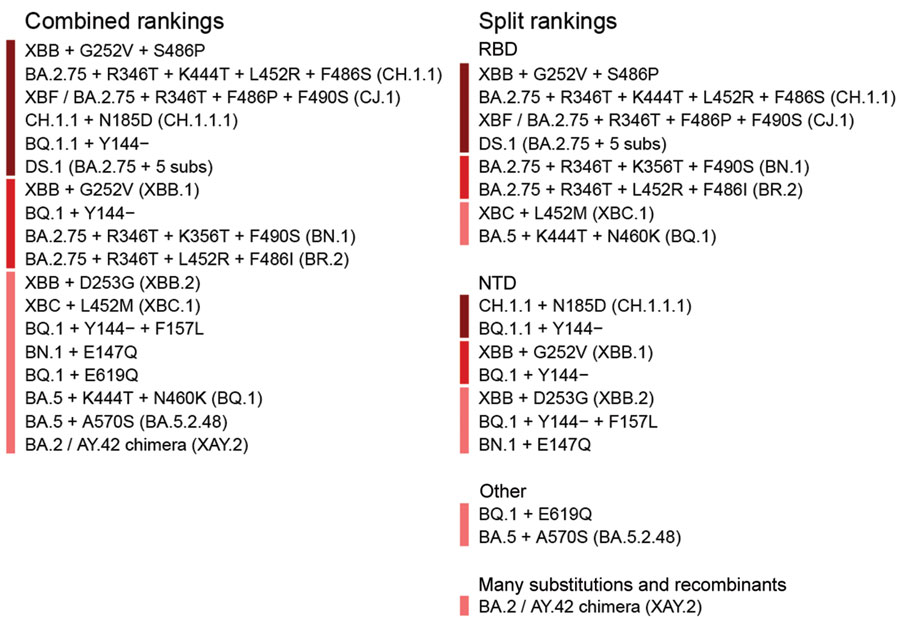Volume 29, Number 5—May 2023
Online Report
US National Institutes of Health Prioritization of SARS-CoV-2 Variants
Figure 1

Figure 1. US National Institutes of Health National Institute of Allergy and Infectious Diseases SARS-CoV-2 Assessment of Viral Evolution Early Detection consortium prioritization of variant rankings from February 2023, produced by taking the consensus of rankings provided by the consortium subgroups. The lineages are shown on the right, split into different functional categories. The colored bars indicate priority categories 1, 2, and 3. This prioritization, and all future prioritizations, can be accessed with supporting information (6) (Appendix 1).
References
- World Health Organization. Tracking SARS-CoV-2 variants [cited 2022 Jan 19]. https://www.who.int/en/activities/tracking-SARS-CoV-2-variants
- European Centre for Disease Prevention and Control. SARS-CoV-2 variants of concern as of 06 January 2022 [cited 2021 Jan 6]. https://www.ecdc.europa.eu/en/covid-19/variants-concern
- Public Health England. SARS-CoV-2 variants of concern and variants under investigation in England: Technical briefing 1 [cited 2022 Oct 26]. https://assets.publishing.service.gov.uk/government/uploads/system/uploads/attachment_data/file/959438/Technical_Briefing_VOC_SH_NJL2_SH2.pdf
- Rambaut A, Holmes EC, O’Toole Á, Hill V, McCrone JT, Ruis C, et al. A dynamic nomenclature proposal for SARS-CoV-2 lineages to assist genomic epidemiology. Nat Microbiol. 2020;5:1403–7. DOIPubMedGoogle Scholar
- Shu Y, McCauley J. GISAID: Global initiative on sharing all influenza data - from vision to reality. Euro Surveill. 2017;22:30494. DOIPubMedGoogle Scholar
- National Institutes of Health. NIH SAVE Early Detection Prioritization Summary [2023 Feb 10]. https://docs.google.com/spreadsheets/d/167uJP9LfJN07410sWaMSKU1Se-4XX687j8IgVX4MV_w/edit#gid=1166031460
- Korber B, Fischer WM, Gnanakaran S, Yoon H, Theiler J, Abfalterer W, et al.; Sheffield COVID-19 Genomics Group. Tracking changes in SARS-CoV-2 spike: evidence that D614G increases infectivity of the COVID-19 virus. Cell. 2020;182:812–827.e19. DOIPubMedGoogle Scholar
- Fischer W, Giorgi EE, Chakraborty S, Nguyen K, Bhattacharya T, Theiler J, et al.; Network for Genomic Surveillance in South Africa (NGS-SA). HIV-1 and SARS-CoV-2: Patterns in the evolution of two pandemic pathogens. Cell Host Microbe. 2021;29:1093–110. DOIPubMedGoogle Scholar
- Bacterial and Viral Bioinformatics Resource Center. SARS-CoV-2 real-time tracking and early warning system for variants and lineages of concern (VoCs/LoCs) [cited 2023 Feb 10]. https://www.bv-brc.org/view/VariantLineage/#view_tab=overview
- Wallace ZS, Davis J, Niewiadomska AM, Olson RD, Shukla M, Stevens R, et al. Early detection of emerging SARS-CoV-2 variants of interest for experimental evaluation. Front Bioinform. 2022;2:
1020189 . DOIPubMedGoogle Scholar - Earnest R, Uddin R, Matluk N, Renzette N, Turbett SE, Siddle KJ, et al.; New England Variant Investigation Team. Comparative transmissibility of SARS-CoV-2 variants Delta and Alpha in New England, USA. Cell Rep Med. 2022;3:
100583 . DOIPubMedGoogle Scholar - Obermeyer F, Jankowiak M, Barkas N, Schaffner SF, Pyle JD, Yurkovetskiy L, et al. Analysis of 6.4 million SARS-CoV-2 genomes identifies mutations associated with fitness. Science. 2022;376:1327–32. DOIPubMedGoogle Scholar
- US Military HIV Research Program. SARS-CoV-2 sequencing tracking [cited 2022 Oct 26]. https://www.hivresearch.org/SARS-CoV-2-sequence-tracking
- Schymkowitz J, Borg J, Stricher F, Nys R, Rousseau F, Serrano L. The FoldX web server: an online force field. Nucleic Acids Res. 2005 Jul 1;33(Web Server issue):W382–8.
- Gregory DA, Trujillo M, Rushford C, Flury A, Kannoly S, San KM, et al. Genetic diversity and evolutionary convergence of cryptic SARS- CoV-2 lineages detected via wastewater sequencing. PLoS Pathog. 2022;18:
e1010636 . DOIPubMedGoogle Scholar - Smyth DS, Trujillo M, Gregory DA, Cheung K, Gao A, Graham M, et al. Tracking cryptic SARS-CoV-2 lineages detected in NYC wastewater. Nat Commun. 2022;13:635. DOIPubMedGoogle Scholar
- Cao Y, Jian F, Wang J, Yu Y, Song W, Yisimayi A, et al. Imprinted SARS-CoV-2 humoral immunity induces convergent Omicron RBD evolution. Nature. 2023;614:521–9.PubMedGoogle Scholar
Page created: March 06, 2023
Page updated: April 20, 2023
Page reviewed: April 20, 2023
The conclusions, findings, and opinions expressed by authors contributing to this journal do not necessarily reflect the official position of the U.S. Department of Health and Human Services, the Public Health Service, the Centers for Disease Control and Prevention, or the authors' affiliated institutions. Use of trade names is for identification only and does not imply endorsement by any of the groups named above.